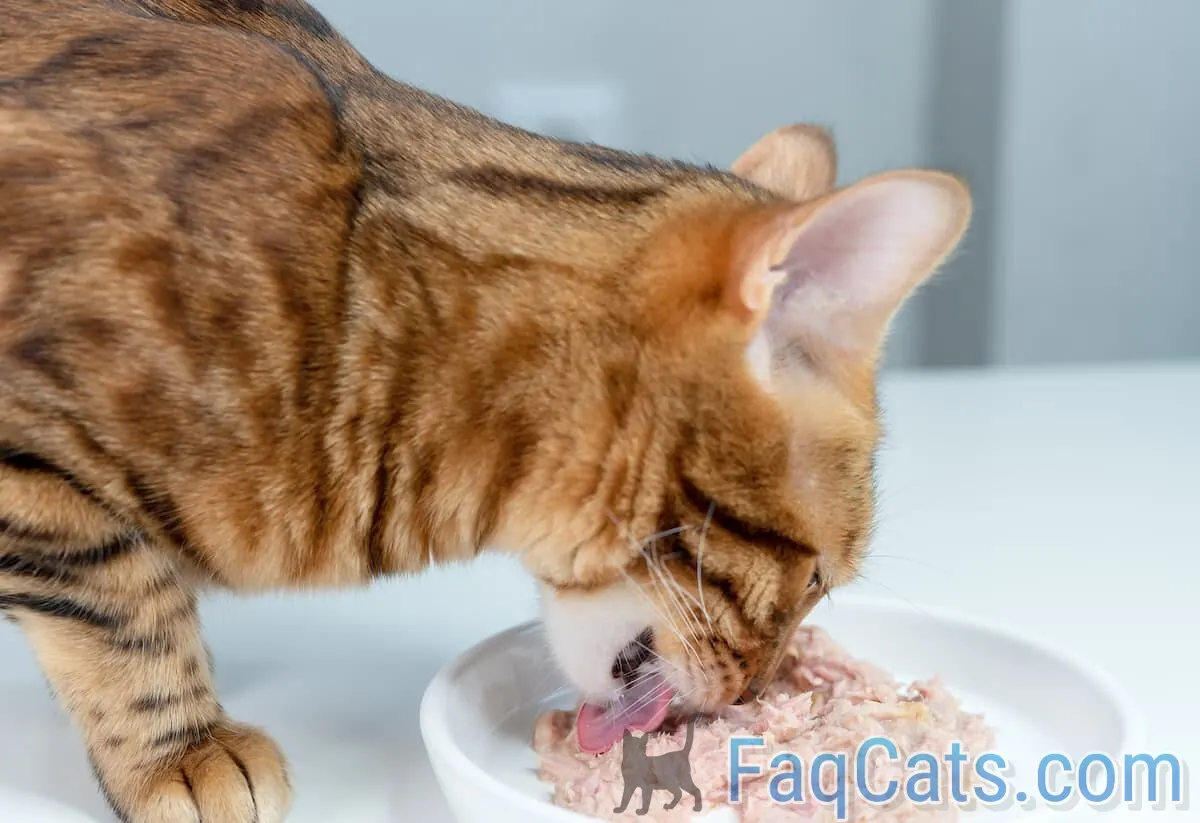There are all kinds of treats that you can give your cat, and you might think that some fish is the best choice. After all, cats love seafood! When you go to the store, you may think that canned tuna is the fastest and easiest option. You may ask yourself this: can cats eat olive oil tuna?
Yes, cats can eat olive oil tuna in moderation. Canned tuna in olive oil or anything else should only be given to your cat as a snack and not as a meal replacement.
Olive oil isn’t one of the better things your cats can eat, but it isn’t the worst either. You should be focusing on the tuna in the can, not what it’s packed in. If you want to learn more about canned tuna, keep reading!

Is Olive Oil Toxic To Cats
Olive oil is not toxic to cats.
When you pick up canned tuna with olive oil or vegetable oil, you may immediately wonder if olive oil is toxic to cats.
Olive oil isn’t toxic. Something that is toxic will also immediately kill your cat.
Although olive oil certainly isn’t toxic to your cat, it isn’t good for your cat to eat regularly.
Olive oil is basically empty calories for your cat, so it is not suitable for your cat to be eating.
Your cat may also experience a stomachache or diarrhea if they do not usually eat olive oil, which can lead to some issues for your cat.
Can Cats Have Vegetable Oil
Cats can have vegetable oil, too, just like olive oil.
Olive oil is a little bit better for your cat if you choose between the two, but your cat can also have vegetable oil in very small amounts.
If you’re looking for canned tuna at the grocery store, you’re probably going to find canned tuna with olive oil.
When comparing the two, olive oil is almost always going to be the better choice for both you and your cat. Vegetable oil is good for frying foods and is highly processed. Olive oil, and especially extra version olive oil, is less processed than vegetable oil or other oils.
Despite being better for your cat overall, your cat can still experience some of the same issues that vegetable oil can cause, including unnecessary weight gain from empty calories, stomach aches, and diarrhea.
Can Cats Eat Oil In Canned Tuna
Cats can eat the oil in canned tuna, but you should drain as much of the oil as possible when giving your cat canned tuna.
Just because there is oil in canned tuna does not mean that your cat needs to be eating or drinking the juices.
The oil is used to preserve the tuna, but you should be fishing the tuna out of the can (no pun intended). You should not slide the tuna and all the juice and oil out of the can for your cat.
You don’t need to go as far as washing or patting the oil off the tuna, but you can if you want to. It may prevent your cat from getting sick from the oil that he is not used to eating regularly.
Whether it is vegetable oil or olive oil, the oil will have at least some added salt to help preserve the tun in the can.
Regardless, one thing to keep in mind is that people think that tuna in oil is the healthier option for both humans and cats, but that may be a little more expensive!
Can Cats Eat Canned Tuna In Water
Canned tuna in water is one of the healthier options if you want to feed our cat canned tuna.
If you’re wandering down the aisles of the supermarket looking for canned tuna, then you want to go for canned tuna in water.
The water in canned tuna will not have any additional, unnecessary calories that your cat may get from olive oil.
One problem with canned tuna in water is going to be the salt in the canned tuna. The salt preserves the tuna, so companies may be tempted to add more salt in water than olive oil.
Canned tuna in water may also be easier to break up from your cat because it is not suspended in oil. The water makes it flakier and easier to eat, which is the perfect texture for your cat.
What Age Can Kittens Eat Tuna
Kittens can begin to eat tuna when they are old enough to easily eat solid foods without choking.
Cats don’t need to be a particular age to eat canned tuna, but you need to make sure that your kitten is able to eat solid food.
Many cat owners will eventually graduate their kittens from wet food mixed with water to dry cat food when their jaws get stronger and bigger. These will be different times for every cat.
Do not feel like you need to immediately change your kitten to eating tuna. Tuna is more of a snack.
When your kitten is eating dry cat food without a problem, you can give them canned tuna for a snack. Tuna is not hard like dry cat food, but you want to do everything you can to limit the possibility of choking.
How Often Should I Give My Cat Tuna
You should give your cat tuna sparingly.
Although we all know that cats like fish, you should not get into the habit of giving your cat tuna all the time, whether it is fresh or canned.
Most of us aren’t going to go out and get fresh tuna for our cats, which means that we’re probably choosing canned tuna.
As we’ve already talked about, canned tuna is not the best choice for your cat because of salt and oils, so you should not be giving your cat that all the time.
You should give your cat canned tuna no more than once or twice a week if that. In this case, the fewer times you give your cat tuna, the better.
How Much Tuna Can I Give My Cat
Tuna is a snack and should not be used as a meal supplement.
We’ve already talked about how often you should give your cat tuna, but how much tuna should you be giving your cat when you do?
Even though you have a whole can of tuna, you should not give your cat the entire can of tuna.
I know, I know. This may seem like a waste of good canned tuna, but an entire can is too much for your cat.
Give your cat a few small pieces of tuna from the cat and keep the rest for later.
Remember: tuna is only a snack for your cat.
Your cat is not eating tuna with the goal of feeling full afterward, so you don’t have to give your cat that much, even if your cat is acting like he is starving!
How To Prepare Tuna For Cats
Fresh tuna is the way to go if you want to start giving your cat more tuna.
Canned seafood is easy enough to figure out since very little preparation is involved. All you need to do is pop the can, break up a few pieces, and give it to your cat.
Fresh tuna is a little bit different and will require more work on your part. We’ll walk you through what you need to do.
Tuna is easy to prepare:
- Add two cups of water to a saucepan.
- Simmer water over medium heat.
- Add tuna to water.
- Boil tuna for about five minutes or until it flakes with a fork.
- Allow to cool and serve.
People think that canned tuna saves time, but fresh tuna is also quick and easy to prepare for your cat!

My name is James, and welcome to FAQCats!
Along with our team of cat owners, expert pet enthusiasts, and pet professionals, we aim to write engaging helpful, engaging content about cats. At FAQCats we strive to provide content that’s accurate and fun to read. Our team writes about everything related to cats; even the most complex of topics. Through extensive research and caring for our own fur-pals, we’re able to provide something cat owners worldwide will love. Have a look around, and leave us feedback anytime!

